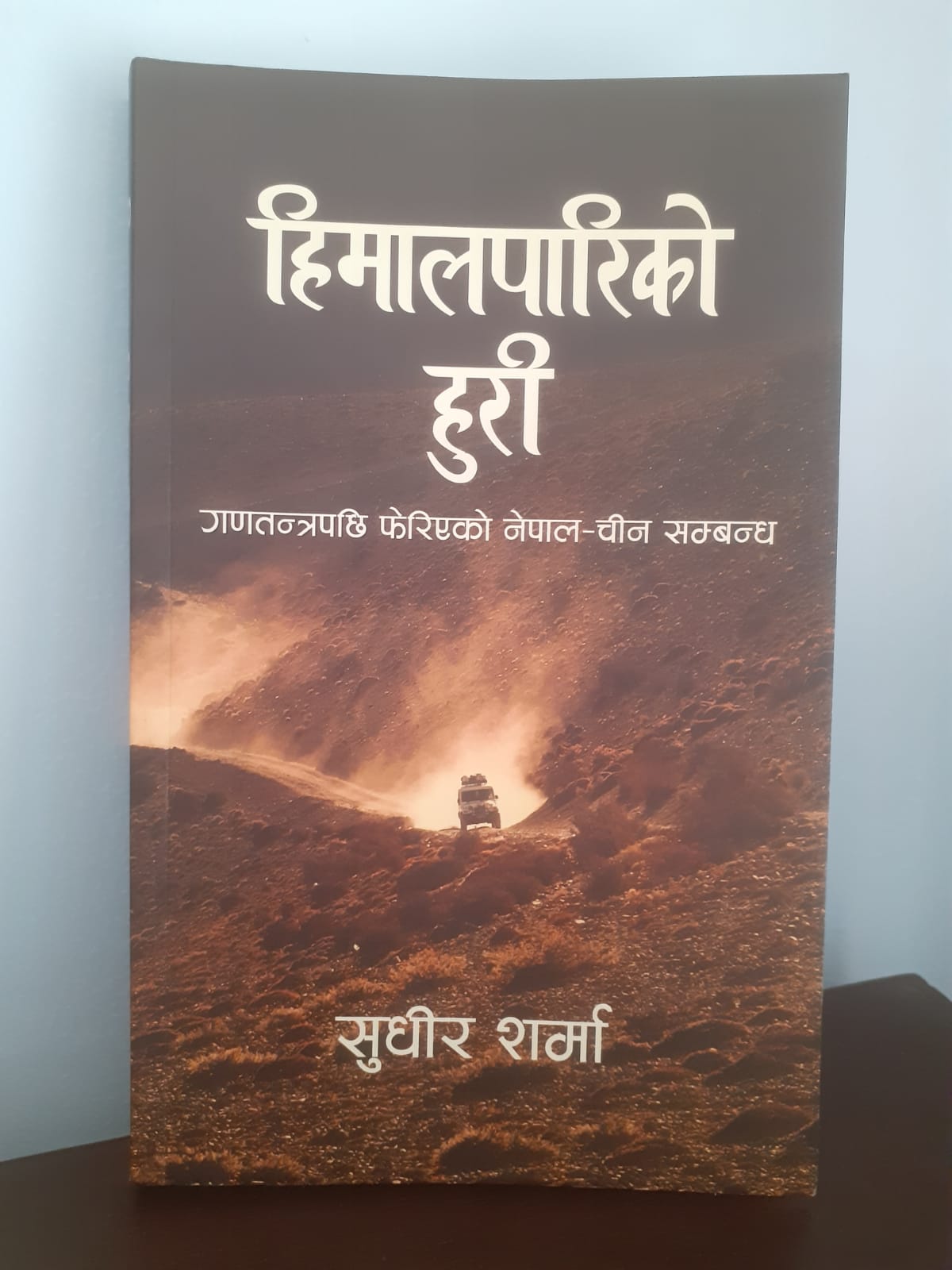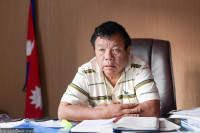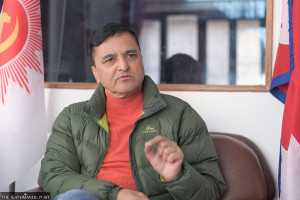Interviews
China should show magnanimity and waive off the Pokhara airport loan
Despite progress in infrastructure development, cross-border social engagement has been hindered. This can be rectified by opening new border points.
Thira Lal Bhusal
Prime Minister KP Sharma Oli is preparing to visit China in the first week of December. It will be his first bilateral visit after assuming the office in mid-July. Nepali prime ministers generally go to New Delhi first. Sudheer Sharma, former editor-in-chief of Kantipur daily, has recently published a pair of books on Nepal-China relations—‘Himalpari ko Huri’ and ‘Bhikshu, Byapar ra Bidroha’. He also frequently writes on Nepal’s relations with its two big neighbours. The Post’s Thira Lal Bhusal sat down with Sharma on the eve of Oli’s China visit.
Prime Minister Oli is all set to visit China next month. Many find it curious that he decided to go to Beijing first before visiting New Delhi. How do you see this development?
Traditionally, Nepali prime ministers have given high priority to visits and engagements with our two neighbours–India and China. This is natural. Generally, the prime ministers first visited India and then went to China. I believe Prime Minister Oli tried to do the same. We see regular engagements with New Delhi at various levels. Prime Minister Oli had met his Indian counterpart Narendra Modi on the sidelines of the UN General Assembly in New York in the last week of September. In August, Foreign Minister Arzu Rana Deuba visited India and met Prime Minister Modi and her counterpart S Jaishankar, among other key officials there. But Delhi has yet to extend the invitation to the prime minister. So he seems to have decided not to defer his foreign visits for long and chose to visit Beijing first.
We have to see this in two perspectives. Prime Minister Oli is visiting China at the invitation of Chinese Prime Minister Li Qiang and he is also going to meet Chinese President Xi Jinping. Even in the past, Oli developed good relations with Chinese leaders. So, there are expectations that he may make the visit fruitful. An equally important concern is whether this visit impacts our relations with the southern neighbour India. I think the prime minister should focus on implementing the agreements reached during his previous visits to Beijing and during Chinese leaders’ Nepal visits. He should be mindful of not irking the southern neighbour while reaching any agreement with the northern one. I believe the prime minister is conscious of this.
India often seems anxious about Chinese involvement in Nepal. Do you see any risk of this visit increasing the distance between Oli and India?
Maoist leader Pushpa Kamal Dahal visited China first after he became prime minister in 2008. Even in the past, some Nepali prime ministers including Tanka Prasad Acharya went to China on their first official visit. This is not unusual. The two prime ministers—Oli and Modi—recently met in New York. India doesn’t seem ready to intensify bilateral engagements with Nepal immediately. So it is natural for the prime minister to increase engagements with China, without taking any steps that could provoke India. We should stop seeking Indian signals when dealing with China, and vice versa. We should maintain parallel relations with both the neighbours without antagonising any side.
In this context, what should be the prime minister’s priorities during his China visit?
We have to end our chronic problem of signing agreements and not implementing them. We make announcements and forget them. There are also some infrastructure projects China pledged to develop but there is little progress. So the prime minister should draw the Chinese leadership’s attention and press them to complete the projects on time. Some important projects such as Mugling-Pokhara and Narayanghat-Butwal road upgradation by the Chinese side have been slow, causing hardships to people. Even such issues should be communicated to the political level. Also, there are several commitments made by the Chinese government but left unimplemented. This creates an impression that China makes big promises but doesn’t keep them.
Prime Minister Oli often highlights the Tokha-Chhahare road upgrade project under Chinese support but there is no satisfactory progress. Progress on preparing the detailed project report (DPR) on Nepal-China cross-border railway is unclear as well. Nepal expected some substantive support from China to make the Pokhara international airport financially feasible. Some concrete steps are needed to operate this airport. There are reports that the government has requested China to convert the loan taken to develop the airport into a grant and the prime minister will push for this during his visit. It will be an achievement if the prime minister succeeds in this.
In the course of writing your recent books, you extensively interacted with Chinese officials and experts, as well as with their Nepali counterparts. What are the major factors delaying the projects? Is it lack of preparation on the Nepali side or is there any problem on the Chinese side?
First, we [Nepalis] sign agreements but don’t work seriously to implement them. This is true in the case of agreements with other countries as well. We are negligent. Red tape is another problem. Third, China gives less priority to small countries like Nepal as it has so many big issues with other countries. We have to constantly follow up with them to speed things up.
In the past, the two sides agreed to open more border points. This should be expedited. The people-to-people relations on the border areas were historically based on social interactions at the community level. People used to trade, marry those from the other side and interact in various ways. Of late, despite progress on infrastructure development, social engagement has been hindered. This should be rectified and new border points should be opened at Dolpa, Mustang, Gorkha, Dolakha, Taplejung, and Sankhuwasabha. We should think beyond the Capital-centric approach. This will help strengthen relations at the people’s level and give alternatives in our connectivity. We should put connectivity at the core of our relations with the two neighbours.
In the past decade, we have made good progress in improving connectivity with India. A study report has been prepared on the Raxaul-Kathmandu railway project. We are building an expressway linking Kathmandu and the southern belt of the country. Integrated check posts (ICPs) have come into operation along Nepal-India border points. Cross border electricity transmission lines have been built and we have increased energy trade with India. We have thus progressed in deepening connectivity with India. We lack reliable north-south highways. Therefore, the prime minister should make connectivity a major agenda of his China visit.
Given the lacklustre performance of past projects, can we be optimistic about big cross-border infra projects under Chinese help?
Nepal and China have committed to run some projects under the Trans-Himalayan Multi Dimensional Connectivity Network (THMDCN) concept. A key component of this concept is to upgrade connectivity between Kathmandu and Kerung that includes roads as well as a railway. The concept also envisions operating other border points. The railway project requires more study and investment and needs to consider various other factors. For now, we should prioritise opening the aforementioned border points. The Korala border point at Mustang has huge potential. Nepal is making a road that connects Mustang with the Sunauli border point with India.

Centuries ago, people from Banaras used to travel to Tibet via Mustang through this route. It can be revived and made a trilateral trade route between Nepal, India and China. Similarly, Limi in Humla, Olangchugola in Taplejung, among others places, can be developed as alternative routes. As far as Kerung-Kathmandu connection is concerned, let’s first give priority to building a reliable highway. The railway project should be developed with a broader understanding between Nepal, India and China. Beijing will develop such a big project only with the big Indian markets in mind. More importantly, there are some signs of improvements in India-China relations. We have to use this as an opportunity.
There are differences in the way we work and the Chinese do and there are systemic and linguistic differences as well. These factors are often blamed for lack of progress in development activities carried out with Chinese support. Can Nepalis work closely with Chinese, just like we do with Indians?
Until a decade ago, several projects developed under Indian support were left in limbo. In 2015, India imposed a blockade against Nepal and that sparked anti-India sentiment. Then, India expedited several projects. This drastic change became possible as the political leadership in India realised its mistake and showed the commitment to improve things.
But the same thing is not happening with China because there is a “great wall” between Nepal and China when it comes to understanding each other. The Chinese haven’t understood Nepali context. The northern neighbour should be more open and liberal in helping Nepal. Second, Nepal should also stop approaching China only when our relations with India sour. We have left this impression on the Chinese psyche. First, we should be clear about what exactly we want from China, forge consensus among major political forces and hold talks with the Chinese leaders. Then, we should be equally committed to implementing the agreements reached this way. People now take announcements of building big projects under Chinese support as propaganda. Therefore, this time the prime minister should stress on pushing the pending projects. The prime minister should tell them that even the projects announced during President Xi’s visit have not progressed and that has created a bad impression of China in Nepal.
There are some differences between the coalition partners—the CPN-UML and the Nepali Congress—about the funding modality of projects under the Belt and Road Initiatives (BRI). Do you think this may cause a problem?
The UML wants to expedite the BRI projects while the Congress has insisted that we should accept only grants and not loans under the BRI. The prime minister should clear such dilemmas and come up with common views before he leaves for Beijing. Once they come up with a common view on such key issues, it will give a positive and strong message. The Chinese side will take it more seriously because the strong government led by the two largest parties can implement bilateral agreements.
We have instances of Nepal’s political parties standing for and against important projects funded by other countries. This was seen in the case of the US-funded Millennium Challenge Corporation (MCC), and China’s BRI. Moreover, in the past, the Chinese leaders created an impression that they preferred working with communist parties and leaders. This is neither in the interest of Nepal nor of China.
There are also discussions on signing the BRI implementation plan during the visit. What are the things Nepal should be careful about while signing BRI-related agreements?
Trying to get grants instead of loans is in itself good. But there is no need to be prejudiced against the BRI per se. Nepal reportedly wants to include some points specifying waivers in specific projects. We should be very careful while signing project-based agreements. For instance, what will be the conditions and funding modality of a project, will it be developed under grants or loans etcetera. All our technical experts and other brains should be engaged while signing project-based agreements and specifying conditions and other nitty-gritty to ensure that we will not have unnecessary liability and debt burden in the future.

Over time, Nepal has rightly adopted a steadfast position saying that we don’t join a strategic alliance proposed by any country. It stayed away from the US government’s State Partnership Programme (SPP) and China’s Global Security Initiative (GSI) as well as from India’s security umbrella. But we can’t be isolated in development initiatives. We have to take support from India, China, the US and other countries based on our needs.
Do you think the Chinese side will show magnanimity on Nepal’s requests, for instance on waiving off the loan to develop Pokhara international airport?
Though the Chinese ambassador to Nepal last year claimed the airport project to be under the BRI, the case is different because it was signed years before we joined the BRI. And, converting that loan into a grant is not a big deal for China. They should show magnanimity given the support we have been providing to China for a long time. If you see things historically, Nepal has helped China by suppressing Khampa revolt, preventing free Tibet movements on our soil and showing a steadfast commitment to One-China policy. China, which is now prosperous, should definitely show magnanimity and waive off loan of Pokhara airport. They shouldn’t see relations with Nepal through a purely transactional lens.
In your book, you describe 2008 as a watershed after which the engagements between Nepal and China increased drastically. But why couldn’t we benefit from the northern neighbour in terms of development?
The Chinese side looks more interested in increasing engagement. They like to showcase their development before foreigners. But more than lavish hospitality, we need substantive support from the neighbour, which has emerged as the world’s second-largest economy. But we should be clear about what we want from our engagements with China.

The Nepali side doesn’t present its proposals clearly. On certain issues, our politicians give mixed signals. This time, if this government of two largest parties reaches a certain agreement with China and remains committed to implement it, other forces can’t hinder it. The same approach can be replicated while dealing with India, the US, Japan or other friendly countries.
Is difficult geography still a barrier in developing cross-border infrastructure projects and deepening relations between Nepal and China?
In our textbooks we read that the Himalayan range is a natural barrier between the two countries. In my book ‘Bhikshu Byapar ra Bidroha’, I have explored and described how people from Nepal and northern India had been traversing through these mountains and there were interactions and engagements between the people in this part of the world since the 5th and 6th centuries. So, the mountains weren’t barriers even at that time. Now technology has made things easier. We have to think about how to connect with these two big economies. We have multiple east-west highways. Now we need north-south highways connecting the three countries that will help us reap benefits from India and China.
At present, relations between these two countries have improved and it is an opportunity for us. We have to forge understanding with both India and China if we have to materialise big projects based on trilateral agreement. One thing we can’t accept is the concept of two-plus-one (India, China plus Nepal). That is unacceptable because it downgrades Nepal to a junior partner. We need trilateral agreements to develop mega connectivity-related and other investment projects but such agreements should be made on an equal-footing between the three countries.




 9.12°C Kathmandu
9.12°C Kathmandu












